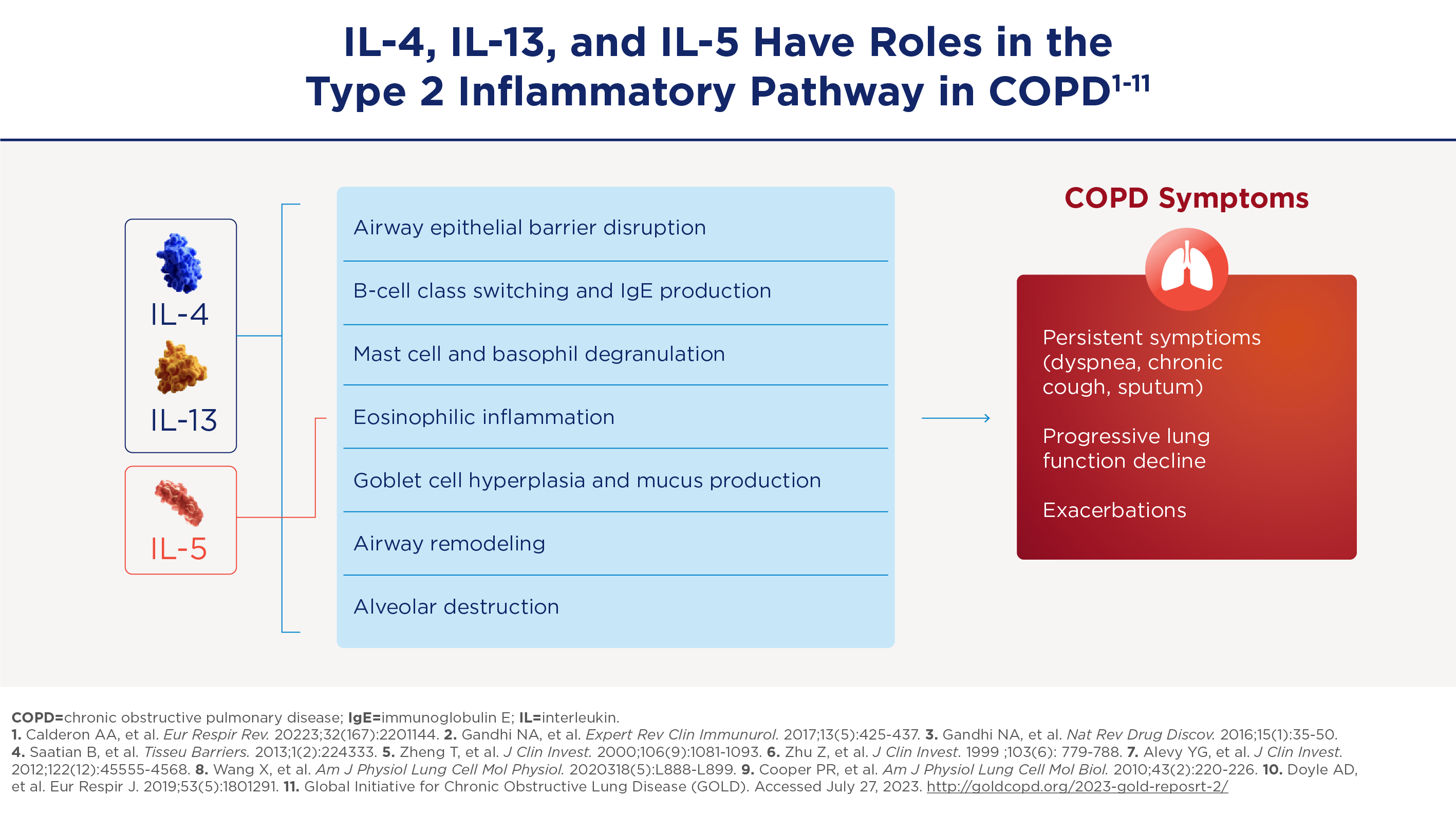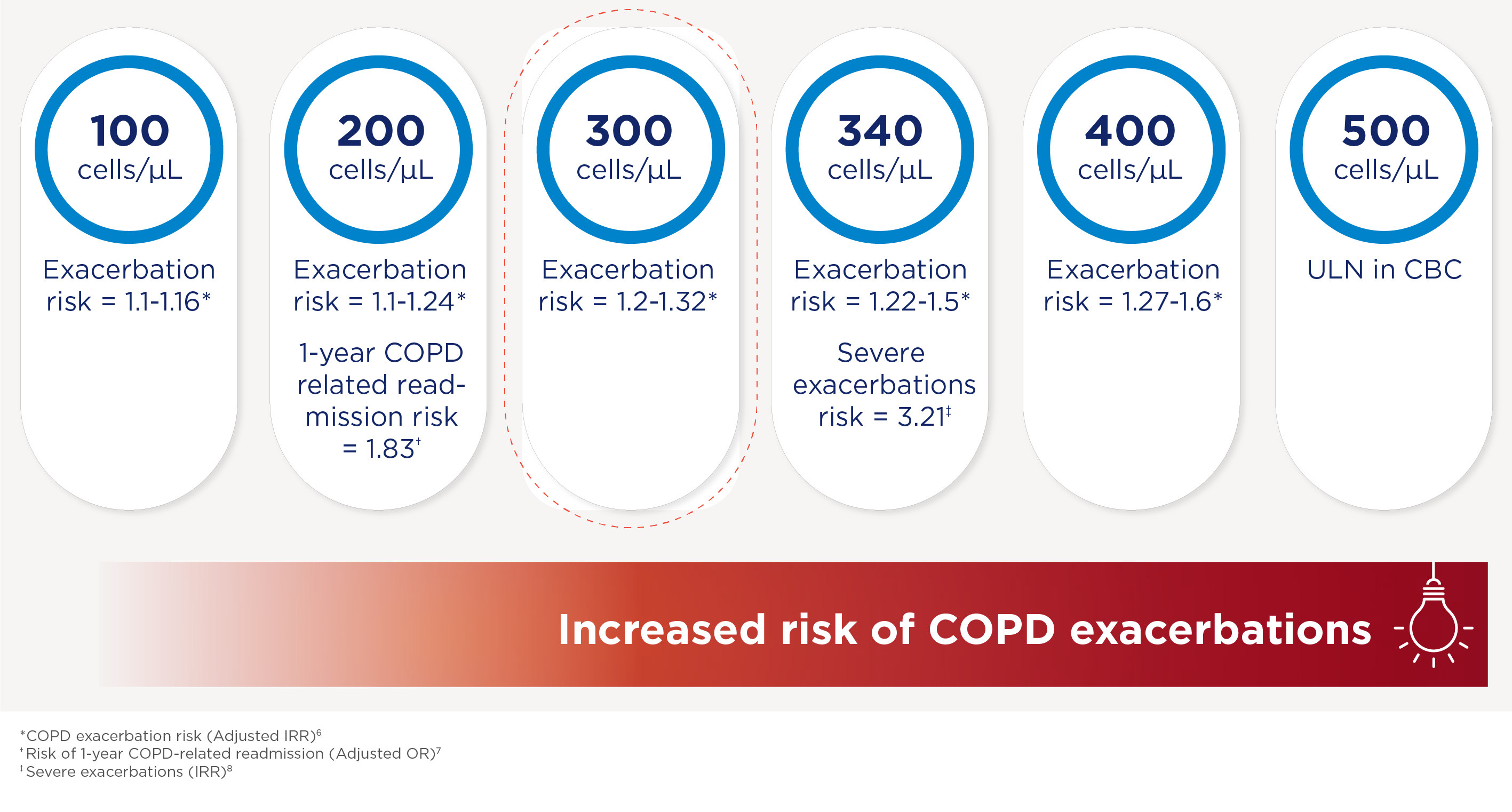- Artikel
- Bron: Campus Sanofi
- 10 jul 2025
Type-2-inflammatie, juist óók bij COPD

Omdat type-2-inflammatie ook vaak bij COPD voorkomt en behandelbaar is, is het relevant dit vroegtijdig te herkennen. En wat zijn nieuwe aangrijpingspunten voor behandeling? Daarvoor kijken we naar wat onderzoek over o.a. interleukinen bij (de behandeling van) COPD aan het licht bracht.6-12
Type-2-inflammatie bij COPD
Dit is een verzamelterm voor een signaalroute die gekenmerkt wordt door stapeling van eosinofielen, mestcellen, basofielen, Th2-lymfocyten, ILC2’s en IgE-producerende B-lymfocyten.10 De inflammatoire cytokines die vrijkomen bij type-2-inflammatie, zoals IL-4, IL-5 en IL-13, spelen een belangrijke rol bij de inflammatoire werking van deze immuuncellen (Figuur 1).10-17

Figuur 1. De impact van IL-4, IL-5 en IL-13 op inflammatie en symptomen bij COPD.
Type-2-inflammatie bij astma, juist óók COPD
Type-2-inflammatie bij COPD vertoont veel overeenkomsten met die bij astma, al zijn er ook verschillen. Zo vindt de inflammatie bij astma plaats in de gehele bronchiaalboom, waarbij er wel variatie is in de betrokkenheid van de grote en kleine luchtwegen. Bij COPD zit de type-2-inflammatie met name in de kleine luchtwegen.18-20 Dit geeft zowel ziekte-specifieke als overlappende pathofysiologie en symptomen.18-26 Een aantal overeenkomstige veranderingen die zowel bij astma als COPD ontstaan zijn luchtwegwandverdikking, mucusproductie en verstoring van de barrièrefunctie van het epitheel.27-34
Bloed-eosinofielen-aantallen (BEC) ook een biomarker bij COPD
Uit studies is gebleken dat de BEC ook bij COPD een voorspeller is van de exacerbatiefrequentie.9 Patiënten met matig tot ernstig COPD en een BEC van 300 cellen/μl of meer hadden in de COPDGene-studie een verhoogd risico op longaanvallen.9

In het GOLD-document 2025 worden bloed-eosinofielen-aantallen dan ook genoemd als goede biomarker voor type-2-inflammatie.30 Bloed-eosinofielen voorspelden in onderzoek de mate van effectiviteit van behandeling met ICS als aanvulling op luchtwegverwijders in het voorkomen van exacerbaties bij COPD.35 Omdat het aantal eosinofielen in het bloed kan fluctueren, geeft eenmalige bepaling geen goed beeld.32 Frequent meten van bloed-eosinofielen is dan ook belangrijk.
-
Brightling C, Greening N. Airway inflammation in COPD: progress to precision medicine. Eur Respir J 2019;54:1900651.
-
Oshagbemi OA, Franssen FME, van Kraaij S, et al. Blood eosinophil counts, withdrawal of inhaled corticosteroids and risk of COPD exacerbations and mortality in the clinical practice research datalink (CPRD). COPD. 2019;16(2):152-159.
-
Casanova C, Celli BR, de-Torres JP, et al. Prevalence of persistent blood eosinophilia: relation to outcomes in patients with COPD. Eur Respir J. 2017;50:1701162. doi:10.1183/13993003.01162-2017
-
Singh D, Kolsum U, Brightling CE, Locantore N, Agusti A, Tal-Singer R; ECLIPSE investigators. Eosinophilic inflammation in COPD: prevalence and clinical characteristics. Eur Respir J. 2014;44(6):1697-1700.
-
Bafadhel M, McKenna S, Terry S, et al. Acute exacerbations of chronic obstructive pulmonary disease: identification of biologic clusters and their biomarkers. Am J Respir Crit Care Med. 2011;184(6):662-671.
-
Koyasu S, Moro K. Type 2 innate immune responses and the natural helper cell. Immunology 2011;132:475-481.
-
Iwaszko M, et al. Significance of interleukin (IL)-4 and IL-13 in inflammatory arthritis. Cells 2021;10:3000.
-
Gandhi NA, Bennett BL, Graham NMH, Pirozzi G, Stahl N, Yancopoulos D. Targeting key proximal drivers of type 2 inflammation in disease. Nat Rev Drug Discov. 2016;15(1):35-50.
-
Barnes PJ. Inflammatory mechanisms in patients with chronic obstructive pulmonary disease. J Allergy Clin Immunol. 2016;138(1):16-27.
-
Gandhi NA, Pirozzi G, Graham NMH. Commonality of the IL-4/IL-13 pathway in atopic diseases. Expert Rev Clin Immunol. 2017;13(5):425-437.
-
Zheng T, Zhu Z, Wang Z, et al. Inducible targeting of IL-13 to the adult lung causes matrix metalloproteinase– and cathepsin-dependent emphysema. J Clin Invest. 2000;106(9):1081-1093.
-
Garudadri S, Woodruff PG. Targeting chronic obstructive pulmonary disease phenotypes, endotypes, and biomarkers. Ann Am Thorac Soc. 2018;15(suppl 4):S234-S238
-
Koyasu S, Moro K. Type 2 innate immune responses and the natural helper cell. Immunology 2011;132:475-481.
-
Iwaszko M, et al. Significance of interleukin (IL)-4 and IL-13 in inflammatory arthritis. Cells 2021;10:3000.
-
Gandhi NA, Bennett BL, Graham NMH, Pirozzi G, Stahl N, Yancopoulos D. Targeting key proximal drivers of type 2 inflammation in disease. Nat Rev Drug Discov. 2016;15(1):35-50.
-
Barnes PJ. Inflammatory mechanisms in patients with chronic obstructive pulmonary disease. J Allergy Clin Immunol. 2016;138(1):16-27.
-
Gandhi NA, Pirozzi G, Graham NMH. Commonality of the IL-4/IL-13 pathway in atopic diseases. Expert Rev Clin Immunol. 2017;13(5):425-437.
-
Zheng T, Zhu Z, Wang Z, et al. Inducible targeting of IL-13 to the adult lung causes matrix metalloproteinase– and cathepsin-dependent emphysema. J Clin Invest. 2000;106(9):1081-1093.
-
Garudadri S, Woodruff PG. Targeting chronic obstructive pulmonary disease phenotypes, endotypes, and biomarkers. Ann Am Thorac Soc. 2018;15(suppl 4):S234-S238
-
Divekar R, Kita H. Recent advances in epithelium-derived cytokines (IL-33, IL-25, and thymic stromal lymphopooietin) and allergic inflammation. Curr Opin Allergy Clin Immunol 2015;15:98-103.
-
Maspero J, et al. Type 2 inflammation in asthma and other airway diseases. ERJ Open Res 2022;8(3):00576-2021.
-
David B, et al. Eosinophilic inflammation in COPD: from an inflammatory marker to a treatable trait. Thorax 2021;76(2):188–195.
-
George L, Brightling CE. Eosinophilic airway inflammation: role in asthma and chronic obstructive pulmonary disease.Ther Adv Chron Dis 2016;7(1):34–51.
-
Harada N, et al. A Retrospective Claims Database Study to Clarify Disease Burden of Severe Asthma Patients with Type 2 High or Low Inflammation. J Asthma and Allergy 2023;16:83–93.
-
Buhl R, et al. Prospective, Single-Arm, Longitudinal Study of Biomarkers in real-World Patients with Severe Asthma. J Allergy Clin Immunol Pract 2020;8(8):2630–2639.e6.
-
Polverino F, Sin DD. Type 2 airway inflammation in COPD. Eur Respir J 2024;63:2400150.
-
Saetta M, Turato G. Airway pathology in asthma. Eur Respir J Suppl 2001;23:18s-23s/
-
Davis JD, Wypych TP. Cellular and functional heterogeneity of the airway epithelium. Mucosal Immunol 2021;14(5):978-990.
-
Saatian B, et al. Interleukin-4 and interleukin-13 cause barrier dysfunction in human airway epithelial cells. Tissue Barriers. 2013;1(2):e24333.
-
Global Initiative for Chronic Obstructive Lung Disease. Global strategy for the diagnosis, management, and prevention of chronic obstructive pulmonary disease (2025 report). Accessed [January 31, 2025]. https://goldcopd.org/2025-gold-report/
-
Georas SN, Rezaee Fl. Epithelial barrier function: at the front line of asthma immunology and allergic airway inflammation. J Allergy Clin Immunol 2014;134(3):509–520.
-
Baraldi F, Bartlett-Pestle S, Allinson JP, et al. Blood eosinophil count stability in COPD and the eosinophilic exacerbator phenotype. Am J Resp Crit Care Med 2025 Jan 15. Doi:10.1164/rccm.202407-1287RL.
-
Sugita K, et al. Type 2 innate lymphoid cells disrupt bronchial epithelial barrier integrity by targeting tight junctions through IL-13 in asthmatic patients. J Allergy Clin Immunol 2018;141(1):300–310.e11.
-
Heijink IH, et al. Epithelial cell dysfunction, a major driver of asthma development. Allergy 2020;75(8):1902–1917
-
Bafadhel M, et al. Predictors of exacerbation risk and response to budesonide in patients with chronic obstructive pulmonary disease: a post-hoc analysis of three randomized trials. Lancet Respir Med 2018;6(2):117-126.
-
Criner GK, et al. Benralizumab for the prevention of COPD exacerbations. N Engl J Med 2019;381:1023-1034.
-
Pavord ID, et al. Mepolizumab for eosinophilic chronic obstructive pulmonary disease. N Engl J Med 2017;377:1613-1629.
-
Bhatt SP, et al. Dupilumab for COPD with Blood Eosinophil Evidence of Type 2 Inflammation. N Engl J Med 2024;390(24):2274-2283.
-
Bhatt SP, et al. Dupilumab for COPD with Type 2 Inflammation Indicated by Eosinophil Counts. N Engl J Med 2023;389(3):205-21.
-
Sciurba FC, et al. Mepolizumab to Prevent Exacerbations of COPD with an Eosinophilic Phenotype. N Engl J Med 2025;392:1710-20.
Neem contact op

MAT-NL-2500423